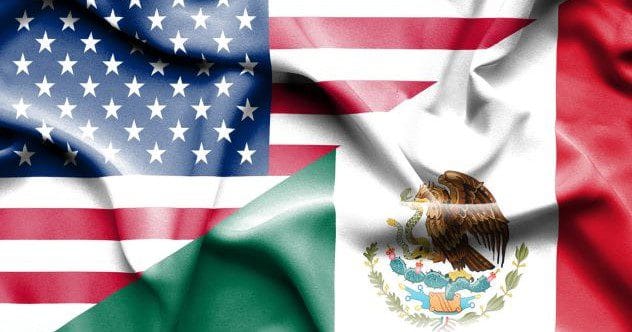History books are filled with tales of epic wars, like World War I and II, or the American Civil War. But what about the conflicts that slip through the cracks of common knowledge? One such war, despite its profound impact, is the Mexican-American War. This clash, starting in 1846, reshaped nations and set the stage for future events, yet many know little about it.
This war wasn’t just a footnote in history; it was a crucial training ground for Civil War generals and, proportionally, one of a_merica’s deadliest conflicts. Plus, it led to the U.S. acquiring a massive chunk of its current territory. It’s time to shed light on this significant yet under-discussed chapter. Let’s dive into ten fascinating facts about this pivotal, and often forgotten, war!
10. An Offer They Had to Refuse: Sell or Face Invasion
Believe it or not, the United States initially tried to buy its way to more western land rather than fight for it. In the 1840s, President James K. Polk had his eye on expanding the nation. He hoped to acquire vast territories then part of northern Mexico, including areas that would become California, New Mexico, and Arizona.
In late 1845, Polk dispatched diplomat John Slidell on a confidential mission to Mexico. Slidell’s official purpose was to resolve a border dispute. However, his secret agenda was to offer the Mexican government $25 million for most of its northern lands. The Mexican government flatly rejected the offer. Polk, angered by the refusal, ordered General Zachary Taylor to lead 4,000 troops into a disputed region in present-day Texas, between the Nueces and Rio Grande rivers—an area Mexico claimed as its own. Polk aimed to provoke a response.
As anticipated, Mexican forces also entered the contested zone. On April 25, 1846, Mexican troops clashed with a small American patrol. This skirmish was the spark. Less than three weeks later, on May 13, the U.S. Congress overwhelmingly declared war on Mexico.
9. A Rehearsal for a Bigger Conflict: The Civil War Trial Run
The Mexican-American War, due to its timing, inadvertently served as a training ground for many officers who would later become prominent generals in the American Civil War. Back in 1846, few could have predicted the internal conflict that would erupt just 15 years later. Yet, the men who honed their skills in Mexico would soon find themselves leading armies against their own countrymen.
Among these figures were three future U.S. presidents: Franklin Pierce, Ulysses S. Grant, and the previously mentioned Zachary Taylor. Other soon-to-be-famous Civil War personalities like Stonewall Jackson, George Pickett, and the renowned Robert E. Lee also saw action in Mexico. Lee, in particular, built his reputation as a brilliant military strategist there. His reconnaissance efforts were instrumental in American victories at battles like Cerro Gordo and Contreras, earning him high regard from military leaders—a reputation that would take a different turn in 1861.
8. Internal Turmoil: Mexico’s Leadership Struggles
Antonio Lopez de Santa Anna, a Mexican military leader, wasn’t exactly a favorite in America, especially after his role at the Battle of the Alamo a decade earlier. Interestingly, Santa Anna leveraged the Mexican-American War to regain power in Mexico, with an unexpected assist from President Polk.
Santa Anna was living in exile in Cuba following a failed dictatorship. Seeing an opportunity, he contacted Polk a few months after the war began in 1846. Santa Anna proposed he could negotiate peace if the Americans helped him return to Mexico by slipping through their naval blockade. Polk agreed and facilitated Santa Anna’s return. However, Santa Anna quickly double-crossed Polk. Upon reaching Mexico, he organized troops and began fighting the American invaders. Polk was furious, but the U.S. was already engaged in the war and now had Santa Anna as a key adversary. He swiftly reclaimed the Mexican presidency and led forces in major battles for the next two years.
7. A Voice of Dissent: Honest Abe’s Opposition to the War
Abraham Lincoln, then a freshman congressman, strongly opposed the Mexican-American War. He wasn’t alone; the conflict sparked one of America’s first significant anti-war movements. Opponents of President Polk viewed the war as an aggressive land grab.
Abolitionists argued that Polk’s true motive was to acquire more territory for slave states, thereby strengthening the South’s influence. Lincoln publicly voiced his disapproval on the House floor. In an 1847 speech, he challenged Polk to identify the exact “spot of soil” where the first skirmish occurred, implying Polk had unjustly provoked Mexico by invading its territory. Lincoln and others introduced “Spot Resolutions” questioning the war’s legitimacy and criticizing Polk. This stance helped Lincoln gain national recognition as a principled politician, long before his presidency.
6. Not by Land, But by Sea: America’s First Amphibious Assault
The Mexican-American War marked a significant military milestone: the first major amphibious attack by U.S. forces on foreign soil. In March 1847, General Winfield Scott executed this daring plan to capture the city of Veracruz. He ordered the construction and use of surfboats to transport over 10,000 American troops from the Gulf of Mexico to the shore.
For nearly six hours, these boats ferried soldiers in continuous waves. The Veracruz garrison, vastly outnumbered, offered minimal resistance. Scott then began a 20-day siege, leading to the surrender of Veracruz and nearby areas. Following this victory, Scott’s forces marched 265 miles inland over six months, eventually reaching Mexico City, the famed “Halls of Montezuma.” This amphibious landing remained America’s largest such operation until World War II, showcasing innovative military tactics.
5. A Surprising Alliance: The Irish Who Fought for Mexico
One of the war’s most intriguing stories involves the St. Patrick’s Battalion, a group of about 200 Irish-American immigrants who defected from the U.S. Army to fight for Mexico. These men, predominantly Catholics, had grown weary of anti-Catholic prejudice in the largely Protestant United States. Seeing a chance to fight alongside fellow Catholics in Mexico, they switched allegiances.
Led by John Riley, the battalion joined Santa Anna’s army and became a respected artillery unit. They fought bravely at the Battles of Buena Vista and Cerro Gordo. However, during a battle at Churubusco in August 1847, most of the unit was either killed or captured. Those captured faced court-martial by the U.S. Army; many were executed, while others were whipped and branded with a “D” for deserter. Despite their fate in the U.S., the “San Patricios,” as they are known in Mexico, are still celebrated as heroes. Mexicans honor them annually on St. Patrick’s Day, a fascinating cultural exchange.
4. Enduring Legends: The Boy Heroes of Chapultepec
Similar to their Irish allies, Mexican soldiers from the war are also remembered and honored today. Among the most notable are the “Niños Héroes,” or Boy Heroes, who defended Chapultepec Castle during a battle just outside Mexico City in September 1847. This fortress, also Mexico’s military academy, stood in the way of American forces advancing on the capital.
General Scott ordered his troops to storm the castle. Outnumbered, most Mexican defenders withdrew. However, six young cadets courageously remained at their posts, fighting to their deaths. According to legend, one cadet, Juan Escutia, wrapped himself in the Mexican flag and leaped from the castle walls to prevent the flag from falling into enemy hands. Whether entirely factual or not, the story of their bravery endures. Mexico has erected a prominent monument to the Niños Héroes in Mexico City, ensuring their sacrifice is never forgotten.
3. A Treaty Forged in Defiance: Treason or Tenacity?
The war’s conclusion was as unconventional as its beginning. By mid-1847, an American victory seemed likely, but the end remained elusive. President Polk sent Nicholas P. Trist, a U.S. State Department clerk, to Mexico City to negotiate a peace treaty with Santa Anna and other Mexican leaders.
Negotiations dragged on. By late November, Polk, frustrated with the lack of progress, ordered Trist to return home. Trist, however, chose to disobey. He sent a lengthy 65-page letter to Washington, explaining why he believed he was close to securing a peace deal, and continued negotiations. Polk was enraged, publicly denouncing Trist and moving to dismiss him. Despite this, Trist persevered, and on February 2, 1848, the Treaty of Guadalupe Hidalgo was finalized. Polk reluctantly accepted the treaty to end the war but never forgave Trist’s insubordination. Upon Trist’s return to Washington, he was promptly fired.
2. A Deadly Toll: One of America’s Costliest Wars
A startling and often forgotten aspect of the Mexican-American War is its incredibly high casualty rate. Although the U.S. did not lose a single major battle, the human cost was immense. Out of approximately 79,000 American soldiers who served, around 13,200 died. This represents a death rate of nearly 17%, making it proportionally deadlier than both World War I and World War II for American forces.
However, most of these deaths were not from combat. Similar to the later Civil War, disease was the primary killer. Dysentery, smallpox, malaria, and yellow fever ravaged the troops. In fact, more U.S. soldiers succumbed to illness than were killed by Mexican forces. Battlefield medicine and hygiene were rudimentary at the time. The tragedy extended to Mexico as well; historians estimate that about 25,000 Mexican soldiers and civilians perished during the conflict.
1. A Nation Reshaped: Mexico’s Vast Territorial Loss
Despite the heavy casualties, the war significantly benefited America’s westward expansion. The Treaty of Guadalupe Hidalgo compelled Mexico to cede over 525,000 square miles (1.36 million square kilometers) of its northern territory to the United States. In return, the U.S. paid Mexico $15 million.
This vast expanse of land, larger than modern-day Peru, now constitutes parts or all of California, Nevada, Arizona, Utah, New Mexico, Colorado, Wyoming, Oklahoma, and southwestern Kansas. It’s ironic that Polk had initially offered $25 million for much of this same land. Mexico’s refusal led to a war that cost nearly 40,000 lives, only for Mexico to ultimately surrender the territory for $10 million less than the original offer. This outcome dramatically altered the map of North America and fueled America’s Manifest Destiny.
The Mexican-American War, though often overshadowed, was a defining moment in the histories of both the United States and Mexico. Its consequences were far-reaching, shaping borders, influencing future conflicts, and leaving a complex legacy that continues to be felt today.
These are just a few facets of a complex and often misunderstood conflict. Which of these facts did you find most surprising? Have you learned anything new about the Mexican-American War today? Share your thoughts and comments below!










